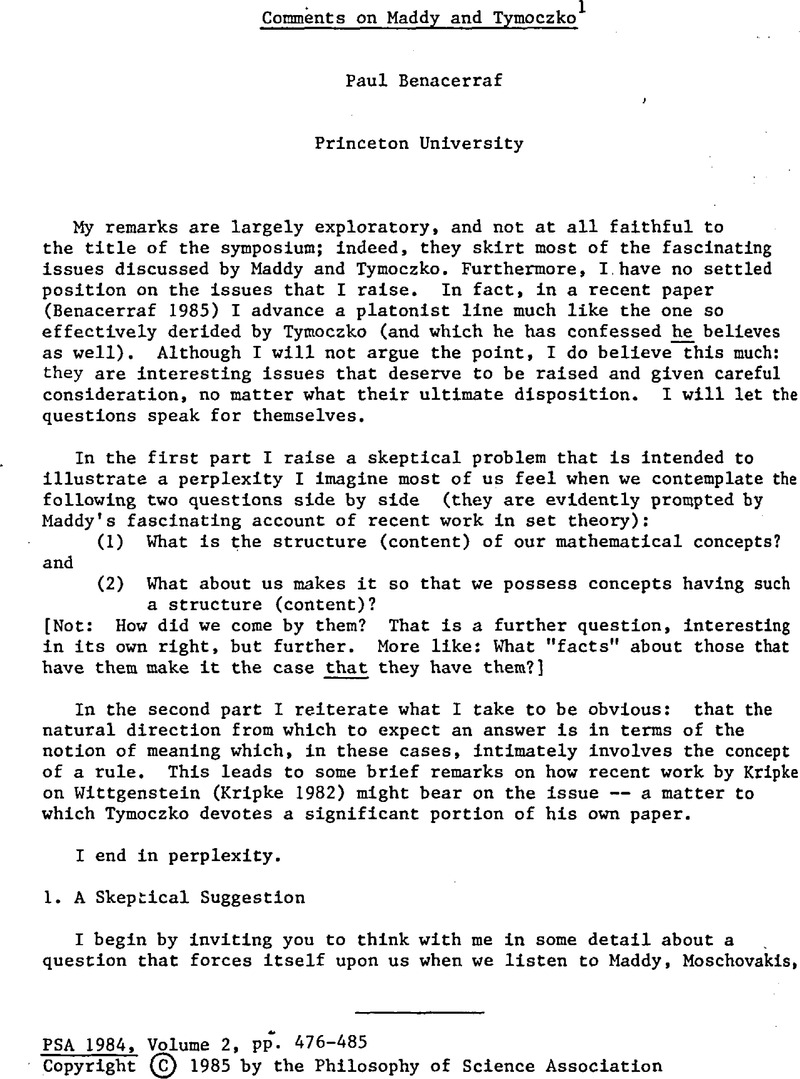No CrossRef data available.
Article contents
Comments on Maddy and Tymoczko
Published online by Cambridge University Press: 28 February 2022
Abstract
An abstract is not available for this content so a preview has been provided. Please use the Get access link above for information on how to access this content.

- Type
- Part XI. New Directions in the Philosophy of Mathematics
- Information
- Copyright
- Copyright © 1985 by the Philosophy of Science Association
Footnotes
1
Comments on (Maddy 1985) and (Tymoczko 1985), constituting, along with comments by George Boolos, a Symposium entitled “New Directions in the Philosophy of Mathematics”, Philosophy of Science Association Meetings, Chicago, October 1984. I am grateful to Paul Boghossian for a number of discussions of Kripke's Wittgenstein. He is blameless for the remarks I make here.
References
Asquith, Peter D and Kitcher, Phili, (eds.). (1985). PSA 1984, Volume 2. East Lansing: Philosophy of Science Association.Google Scholar
Benacerraf, Paul (1973). “Mathematical Truth.” Journal of Philosophy 70: 661-680. (As reprinted in Benacerraf and Putnam (1983). Pages 403-120.CrossRefGoogle Scholar
Benacerraf, Paul and Putnam, Hilar, (eds.). (1983). Philosophy of Mathematics Selected Readings. 2nd ed. New York: Cambridge University Press.Google Scholar
Benacerraf, Paul (1985). “Skolem and the Skeptic.” Proceedings of the Aristotelian Society, Supplementary Volume LIX: 85-115.CrossRefGoogle Scholar
GÖdel, Kur. (1947/64). “What is Cantor's Continuum Problem.” American Mathematical Monthly 54: 515-525. (As reprinted in Benacerraf and Putnam (1983). Pages 470-485.CrossRefGoogle Scholar
Hallett, Michael (1984). Cantorian Set Theory and Limitation of Size. Oxford: Clarendon Press.Google Scholar
Kreisel, Georg (1965). “Informal Rigour and Completeness Proofs.” In Problems in the Philosophy of Mathematics. (Proceedings of the International Colloquium in the Philosophy of Science. London, 1965, Volume 1.) Edited by Imre Lakatos. Amsterdam: North Holland. Pages 138-171.Google Scholar
Kripke, Saul A (1982). Wittgenstein on Rules and the Private Language Argument. Cambridge, MA: Harvard University Press.Google Scholar
Maddy, Penelope (1985). “New Directions in the Philosophy of Mathematics.” In Asquith and Kitcher (1985). Pages 427-448.Google Scholar
Scott, Dana (1974). “Axiomatizing Set Theory.” In Axiomatic Set Theory. (Proceedings of Symposia in Pure Mathematics. Volume 13, Part II.) Edited by T.J. Jech. Providence: American Mathematical Society. Pages 207-214.CrossRefGoogle Scholar
Tymoczko, Thomas (1985). “GÖdel, Wittgenstein, and the Nature of Mathematical Knowledge.” In Asquith and Kitcher (1985). Pages 449-468.Google Scholar
van Aken, Jame (Forthcoming). “Axioms for the Set Theoretic Hierarchy.” Journal of Philosophiocal Logic.Google Scholar
Wittgenstein, Ludwig (1953). Philosophical Investigations, (trans.) Anscombe, G.E.M. New York: MacMillan.Google Scholar


